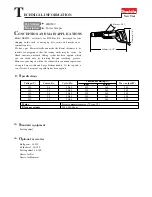
page 6
Use clamps or another practical way
to support and secure the workpiece
to a stable platform.
Holding the work
by hand or against your body leaves it
unstable, and may lead to loss of control.
Know your power tool. Read the
Owner’s Manual carefully. Learn the
applications and limitations, as well as
the specific potential hazards related
to this tool.
Following this rule will
reduce the risk of electric shock, fire or
serious injury.
Always wear safety glasses with side
shields. Everyday glasses only have
impact-resistant lenses. They are NOT
safety glasses.
Following this rule will
reduce the risk of eye injury.
Protect your lungs. Wear a face or
dust mask if the operation is dusty.
Following this rule will reduce the risk of
serious personal injury.
Protect your hearing. Wear hearing
protection during extended periods of
operation.
Following this rule will reduce
the risk of serious personal injury.
Battery-operated tools do not have to
be plugged into an electrical outlet.
Therefore, they are always in operating
condition. Be aware of possible
hazards when not using your battery-
operated tool or when changing
accessories.
Following this rule will
reduce the risk of electric shock, fire or
serious personal injury.
Do not place battery-operated tools
or their batteries near fire or heat.
This will reduce the risk of explosion and
possibly injury.
Do not crush, drop or damage the
battery pack. Do not use a battery
pack or charger that has been dropped
or that has received a sharp blow.
A
damaged battery is subject to explosion.
Properly dispose of a dropped or
damaged battery immediately.
Batteries vent hydrogen gas, and can
explode in the presence of a source
of ignition, such as a pilot light.
To
reduce the risk of serious personal injury,
never use any cordless product in the
presence of an open flame. An exploded
battery can propel debris and chemicals.
If exposed, flush with water immediately.
Do not charge a battery-operated tool
in a damp or wet location.
Following this
rule will reduce the risk of electric shock.
For best results, your battery-operated
tool should be charged in a location
where the temperature is higher than
50°F(10°C) but lower than 104°F(40°C).
Do not store outside or in a vehicle.
Under extreme usage or temperature
conditions, battery leakage may occur.
If liquid comes into contact with your
skin, wash immediately wit soap and
water, then neutralize using lemon
juice or vinegar. If liquid gets in your
eyes, flush them with clean water for at
least 10 minutes, then seek immediate
medical attention.
Following this rule will
reduce the risk of serious personal injury.
Save these instructions.
Refer to them
frequently and use them to instruct others
who may use this tool. If you lend this tool
to someone, also lend these instructions
to them.
If the power supply cord is damaged,
it must be replaced by the manufacturer
or by an authorized service center to
avoid risk.
SAFETY RULES FOR CHARGER
WARNING:
Read and
understand all instructions. Failure to
follow all instructions listed below may
result in electric shock, fire, and/or
serious personal injury.
Before using the battery charger,
read
all instructions and cautionary markings
in this manual and on the battery charger,
the battery, and the product using the
battery to prevent misuse of the products
and possible injury or damage.
CAUTION:
To reduce the
risk of electric shock or damage to the
charger and battery, charge only these
rechargeable batteries specifically
designated on your charger’s label. Other
types of batteries may burst, causing
personal injury or damage.
Do not use the charger outdoors or
expose it to wet or damp conditions.
Water entering the charger will increase
the risk of electric shock.
Содержание HAMMERHEAD
Страница 16: ...2011 Menard Inc Eau Claire WI 54703 06 2011...


































